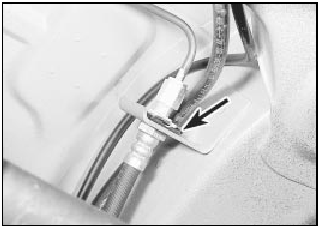Brake fluid pipes and hoses - removal and refitting
Caution: Refer to the precautions in Section 1.
Removal
1 To remove a flexible hose, always free it
from any mounting bracket(s) first by prising
out the U-shaped retaining clip, and then
using two close-fitting spanners to disconnect
the hose-to-rigid pipe union (see illustration).

26.1 Flexible hose-to-rigid pipe union. U-shaped retaining clip arrowed
2 Once disconnected from the rigid pipe, the flexible hose may be unscrewed from the caliper or wheel cylinder union, as applicable.
Refitting
3 When reconnecting pipe or hose fittings,
note that the seal is made at the swaged end
of the pipe, so do not continue to tighten a
union if it is tight, yet still stands proud of the
surface into which it is screwed.
4 A flexible hose must never be installed twisted, but a slight “set” is permissible to give it clearance from adjacent components.
This can be achieved by turning the hose slightly before fitting the U-shaped retaining clip to the mounting bracket.
5 Rigid pipelines can be made to pattern by motor factors supplying brake components.
See also:
Rear shock absorbers (Van models) - removal, testing and
refitting
Removal
1 Raise and support the rear of the vehicle on
stands (see “Jacking and Vehicle Support”).
Place a jack beneath the rear axle tube and
just raise it slightly.
2 Disconnect the shock absor ...
Cylinder head - inspection and renovation
Note: On engines fitted with hardened valve
seats for use with unleaded petrol, valve and
valve seat grinding and recutting cannot be
carried out without the use of specialist
equipment. Consult a ...
Seat belts - removal and refitting
Front seat belt stalk
1 Remove the front seat.
2 Detach the seat belt stalk from the seat by
removing the two Torx screws.
3 Refitting is a reversal of removal.
Front seat belt assembly
4 Where ...
